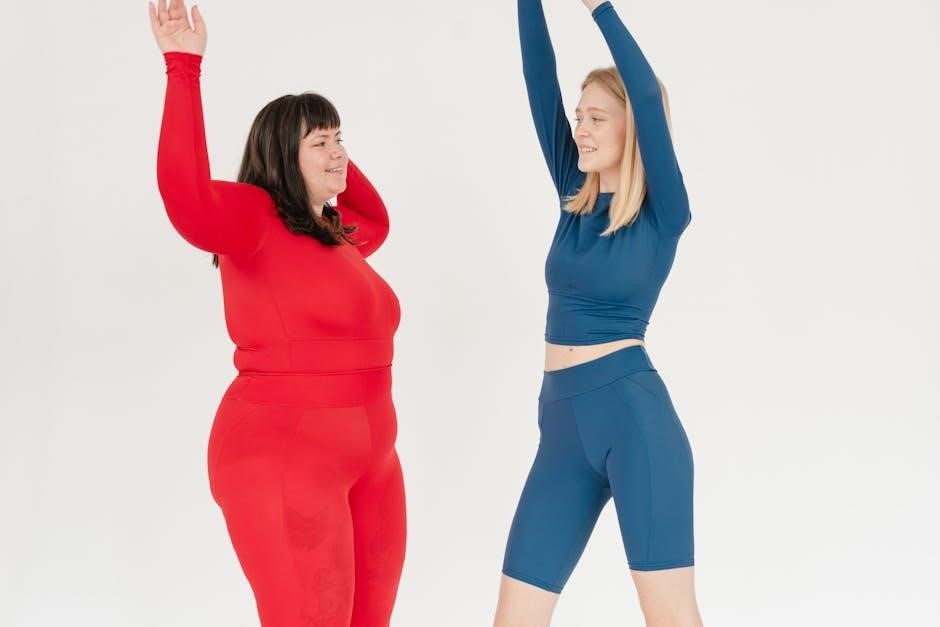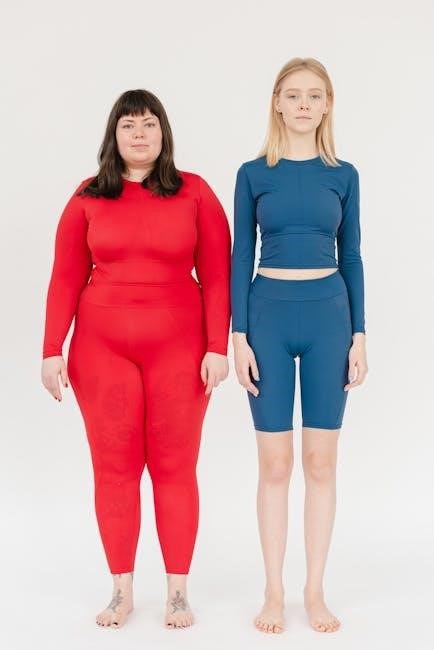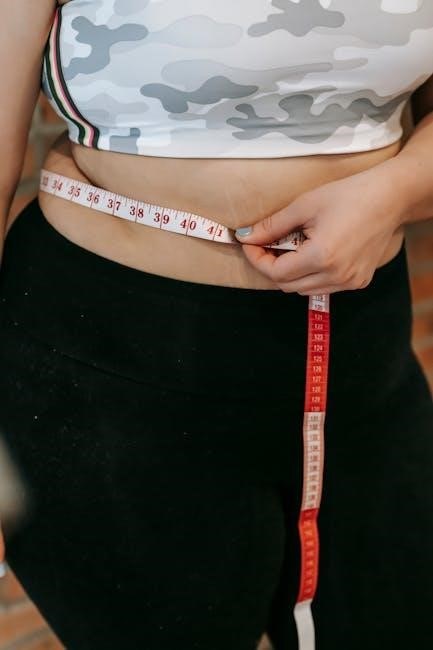Bra size refers to the measurements used to fit bras, consisting of a band size and cup size. It ensures proper support and comfort, with band size indicating torso measurement and cup size denoting breast volume. Accurate sizing is crucial for both comfort and health.
1.1 What is a Bra Size?
A bra size is a combination of two measurements: the band size and the cup size. The band size indicates the circumference of the torso, measured directly under the bust where the bra band sits. The cup size represents the volume of the breasts relative to the band size. Together, these measurements ensure a proper fit, providing comfort, support, and confidence. Bra sizes are not universal, as they can vary between brands and regions, making accurate measurements essential. Understanding your bra size is crucial for choosing the right bra that offers both comfort and adequate support, ultimately enhancing your overall well-being and appearance.
1.2 History of Bra Sizing
The concept of bra sizing has evolved significantly over time. In the early 20th century, bras were available in minimal sizes, often labeled as small, medium, or large. The modern bra sizing system, combining band and cup measurements, emerged in the 1920s. Cup sizes were introduced to better fit diverse breast shapes and sizes, with letters (A, B, C, etc.) representing cup volume. Initially, sizing standards varied widely between brands and regions, leading to inconsistencies. Today, while sizing systems are more standardized, variations still exist, especially across different countries. The history of bra sizing reflects a growing understanding of the importance of proper fit for comfort and health, though universal sizing standards remain elusive.
1.3 Evolution of Bra Sizes
Bra sizes have expanded significantly to accommodate diverse body types and preferences. Traditionally, sizes ranged from A to D, but modern offerings now include up to size N. This growth reflects increased awareness of body diversity and the demand for inclusive sizing. Additionally, advancements in manufacturing have enabled the production of more precise sizes, catering to a broader range of consumers. The rise of personalized fit options and customizable bras further highlights the industry’s adaptability. Despite these advancements, achieving universal consistency across brands and regions remains a challenge. The evolution of bra sizes underscores the ongoing effort to provide better fit, comfort, and support for all individuals.

Importance of Proper Fit
Proper bra fit enhances comfort, boosts confidence, and improves appearance. It prevents health issues like back pain and poor posture, ensuring long-term well-being and self-assurance.
2.1 Health Benefits
A properly fitting bra offers numerous health benefits. It prevents back and shoulder pain caused by inadequate support and reduces the risk of poor posture. A well-fitted bra also minimizes breast tissue strain, lowering the chance of discomfort or long-term damage. Additionally, it can help avoid skin irritation and chafing from ill-fitting bands or cups. Proper support is especially crucial for larger busts, as it distributes weight more evenly, alleviating strain on the shoulders and upper back. A good bra also promotes better breathing and reduces muscle fatigue, contributing to overall physical well-being; Ensuring a proper fit is essential for maintaining both short- and long-term health benefits.
2.2 Comfort and Confidence
A well-fitted bra significantly enhances comfort and confidence. Properly sized bras eliminate discomfort from digging straps or bands, ensuring a seamless fit. This allows for unrestricted movement and reduces irritation throughout the day. Comfort boosts confidence, as women feel more at ease in their own skin. A supportive bra can also improve posture, making individuals feel more self-assured. The right fit ensures breasts are securely held, preventing unnecessary jiggling or shifting, which can be distracting. Additionally, a comfortable bra fosters a positive body image, as it provides a smooth silhouette under clothing. Confidence gained from proper fit translates into everyday activities, empowering individuals to feel their best. Thus, a good bra is not just functional but also a key to emotional well-being.

2.3 Impact on Appearance
A properly fitted bra significantly enhances overall appearance by creating a smooth silhouette under clothing. It ensures breasts are aligned correctly, preventing unevenness or gapping in fabrics. A well-fitted bra also minimizes visible lines or bulges, offering a polished look. The right cup size ensures breasts are fully contained, avoiding spillage that can distort outfits. Additionally, a supportive bra improves posture, making the body appear more balanced and confident. The combination of proper alignment and smooth lines creates a more flattering and put-together appearance, boosting self-assurance in various settings. Ultimately, a well-chosen bra balances style and functionality, ensuring both comfort and a visually appealing fit.

How to Measure Your Bra Size
To measure your bra size, wrap a tape snugly under your bust for the band size and around the fullest part for the cup size. Consistency and accuracy ensure the best fit.
3.1 Preparing for Measurement
To ensure accurate bra size measurement, wear a non-padded, non-push-up bra for a natural breast shape. Use a soft measuring tape, keeping it snug and parallel to the floor. Stand upright and relaxed, avoiding tight clothing that could restrict movement. For consistency, measure at the same time of day, as fluctuations can occur. If self-measuring, use a mirror for visibility. Ensure the tape is level and not twisted. Measurements may not be 100% precise due to natural variations in breast shape. Regular remeasuring is recommended, especially during weight or hormonal changes. Accurate preparation ensures a more reliable fit and comfort in your bra choice.
3.2 Band Measurement
Measure your band size by wrapping a soft measuring tape snugly around your torso, directly under your bust. Ensure the tape is parallel to the floor and level across your back. If the measurement is an even number, it’s your band size; if odd, round up to the next even number. This measurement determines the bra’s band, ensuring proper support and comfort. Accuracy is crucial, as a poorly fitted band can lead to discomfort or lack of support. The band should feel snug but not too tight, allowing for easy breathing and movement. Correct band measurement is the foundation of a well-fitting bra. Consistency in measurement is key for accurate results.
3.3 Bust Measurement
To measure your bust, wrap the tape around the fullest part of your breasts, ensuring it remains parallel to the floor. Keep the tape snug but not tight, with your arms relaxed at your sides. This measurement helps determine your cup size when compared to your band size. For accuracy, wear a non-padded, non-push-up bra or no bra at all. If the tape slips, adjust it to maintain levelness across your back and under your arms. The bust measurement, combined with the band size, provides your complete bra size. Consistency is key, so ensure the tape is in the same position for both measurements. Accurate bust measurement is essential for a comfortable and supportive fit.
3.4 Determining Cup Size
Cup size is determined by the difference between your bust and band measurements. Subtract the band size from the bust measurement to find your cup size. Each inch of difference corresponds to a cup size, starting from A (1 inch). For example, if your band size is 34 and your bust is 36, the difference is 2 inches, resulting in a B cup. Ensure the tape is snug and level during both measurements for accuracy. This calculation provides a baseline, but bra sizing can vary between brands, so it’s essential to refer to specific size charts. Proper cup size ensures optimal comfort and support, making it a crucial step in finding the right bra.
3.5 Importance of Accurate Measurements
Accurate measurements are essential for finding a bra that fits comfortably and provides the right support. Incorrect sizing can lead to discomfort, skin irritation, and even long-term health issues like back pain. Proper measurements ensure the bra band sits snugly without digging into the skin, while the cups fit without gaping or spilling over. This accuracy also prevents premature wear and tear on the bra. For activities like sports, precise sizing is critical for adequate support and mobility. Remember, bra sizes can vary between brands, so consistent and precise measurements are key to finding the perfect fit. Regular remeasuring is recommended, as body changes can affect size.

Understanding Bra Size Charts and Conversions
Bra size charts vary by region and brand, with standard sizes differing across the USA, Europe, UK, and Australia. Understanding conversions and sister sizes ensures consistency and proper fit.
4.1 Standard Bra Size Charts
Standard bra size charts provide a structured system for determining bra sizes, combining band and cup measurements. These charts typically include a range of sizes, accommodating various body types. Band sizes are usually numerical, from 32 to 46, while cup sizes range from AA to O. The charts are designed to help individuals find their ideal fit based on precise measurements. Different brands and regions may slightly vary in their sizing standards, but the core principle remains consistent. Using these charts ensures a more accurate fit, enhancing comfort and support. Proper use of the chart can help individuals avoid common sizing mistakes and find their optimal bra size.

4.2 Regional Bra Size Differences
Bra sizing can vary significantly across regions due to differences in measurement standards and body type preferences. For instance, US and UK sizing systems differ slightly, while European sizes often follow their own conventions. Australian and Asian sizes may also diverge, reflecting regional body type averages. These variations mean a size in one country may not translate directly to another. For example, a US size 34B might not align perfectly with a UK or European size. Understanding these differences is crucial when shopping internationally or comparing sizes across brands. Many brands provide conversion charts to help navigate these regional disparities, ensuring a better fit regardless of location.
4.3 Sister Sizes Explained
Sister sizes are bra sizes that share the same cup volume but differ in band size. For example, a 34B and a 36A are sister sizes, as they offer the same cup capacity but with varying band lengths. This concept is helpful when your current bra size is unavailable or doesn’t fit perfectly. Sister sizes allow you to maintain the same cup volume while adjusting the band size for a better fit. To find sister sizes, you can either increase the band size and decrease the cup size or vice versa. This flexibility is particularly useful for women whose measurements fall between standard sizes. Understanding sister sizes can help you find a more comfortable and accurate fit, even if your exact size isn’t available.

Factors Influencing Bra Size
Breast shape, weight fluctuations, and hormonal changes significantly impact bra size. Variations in breast density and body proportions also affect fit, requiring regular remeasurement for accuracy.
5.1 Breast Shape and Size Variations
Breast shape and size can vary significantly among individuals, influencing bra fit. Common shapes include round, teardrop, and asymmetric, each requiring different cup styles. Size variations, from petite to full-bust, affect band and cup measurements. Understanding these differences helps in selecting bras that provide optimal support and comfort. Additionally, breast density and spacing play roles in determining the best fit. These variations emphasize the importance of accurate measurements and trying bras before purchase to ensure they accommodate unique breast characteristics effectively. Proper fit is essential for both comfort and health, making awareness of breast shape and size crucial in choosing the right bra.
5.2 Weight Fluctuations and Bra Size
Weight changes can significantly impact bra size, affecting both band and cup measurements. Gaining weight often leads to an increase in both bust and band size, while weight loss may result in a decrease. Even small fluctuations can alter how a bra fits, making regular remeasurements essential. For instance, a larger bust may require a bigger cup size, while a slimmer torso might need a smaller band. Proper fit is crucial for comfort and support, so staying aware of body changes ensures the best bra size. Weight fluctuations highlight the importance of adapting to sizing changes to maintain optimal comfort and confidence in one’s bra choice over time.
5.3 Hormonal Changes and Bra Fit
Hormonal fluctuations can significantly affect bra fit by altering breast size and shape. During menstruation, pregnancy, or menopause, breast tissue may expand or contract due to hormone-level changes. This can lead to temporary or permanent shifts in cup size. For example, water retention and breast tenderness during the menstrual cycle may cause a slight increase in bust measurement. Pregnancy often results in a more permanent enlargement of the breasts, necessitating a larger cup and band size. Similarly, hormonal changes during menopause can cause breasts to become smaller or denser, requiring adjustments to bra size. Regular measurements and professional fittings are essential to ensure continued comfort and support as these changes occur.

Types of Bras and Their Sizes
Different bras cater to various needs, each with specific size considerations. Everyday bras offer comfort, sports bras provide support, and maternity bras accommodate changing bust sizes, ensuring fit and function.
6.1 Everyday Bras: Fit and Size
Everyday bras are designed for comfort and versatility, suitable for daily wear. Proper fit is essential, with a snug band and cups that fully contain the breasts without spillage. The band should sit level around the torso, providing support without digging; Cup size must match breast volume, ensuring a smooth silhouette under clothing. Many everyday bras feature breathable fabrics and soft linings, enhancing comfort. Correct sizing ensures all-day support and prevents discomfort or restricted movement. Regular remeasuring is recommended to maintain the best fit, as body changes can affect size. A well-fitted everyday bra promotes confidence and comfort, making it a wardrobe staple.
6.2 Sports Bras: Size and Support
Sports bras are designed to provide varying levels of support for active lifestyles, categorized as low, medium, or high impact. Proper sizing is crucial for optimal performance and comfort. Band size should be snug, offering strong torso stability, while cup size must fully encase breasts to minimize movement. To measure, wrap the tape snugly under the bust for band size and around the fullest part of the bust for cup size. Cup size is determined by the difference between bust and band measurements. Many sports bras feature moisture-wicking fabrics and breathable designs to enhance comfort during exercise. Correct sizing ensures reduced bounce and strain, allowing for better focus on physical activities. Regular remeasuring is recommended to maintain the best fit and support level for varying sports activities.
6.3 Maternity and Nursing Bras: Sizing Considerations
Maternity and nursing bras are tailored for comfort and functionality during pregnancy and breastfeeding. Proper sizing ensures adequate support and accessibility for nursing. Band size should be snug but not restrictive, while cup size must accommodate breast expansion. Measure under the bust for band size and around the fullest part of the bust for cup size. Look for adjustable straps and wide bands for comfort. Cups should be seamless and soft to avoid irritation. Many feature drop-down cups or clasps for easy nursing access. Correct sizing prevents discomfort and ensures proper breast health. Regular remeasuring is essential due to breast changes. Professional fittings can offer personalized advice for the best fit and support during this period.

Common Mistakes When Choosing Bra Size
Common mistakes include wearing an incorrect band or cup size, not considering breast shape, and ignoring the need for regular remeasurements. Proper fit is essential for comfort and support.
7.1 Incorrect Band Size
An incorrect band size is a common issue, often due to improper measurement. The band should fit snugly around the torso, parallel to the floor, and sit level with the bust. Many women wear bands that are too tight or too loose, leading to discomfort and poor support. To measure accurately, wrap the tape around the ribcage, just under the bust, ensuring it lies flat and isn’t twisted. Adding 3 inches to this measurement gives the band size. Ignoring this step or guessing the size can result in a band that rides up or digs into the skin, causing discomfort and affecting the bra’s overall fit and functionality. Regular remeasurements are essential as body changes can alter band size.
7.2 Wrong Cup Size
A wrong cup size is a frequent mistake, often due to improper bust measurement. Cup size is determined by the difference between the band and bust measurements. Each inch represents a cup size increment (e.g., 1 inch = A, 2 inches = B). To measure accurately, place the tape at the fullest part of the bust, ensuring it’s parallel to the floor and not too tight or loose. Many women wear cups that are too small, causing spillage, or too large, leading to gapping. This can result in discomfort, poor support, and an unflattering appearance. Regular remeasurements are essential, as breast size and shape can change over time. Proper cup fit ensures optimal comfort and a natural look.
7.3 Not Considering Breast Shape
Ignoring breast shape is a common mistake when choosing a bra size. Breasts come in various shapes, such as round, teardrop, or asymmetrical, and each shape requires a specific bra style for proper fit. For example, women with fuller busts may need bras with additional support, while those with narrower breasts might prefer certain cup styles. Failing to account for breast shape can lead to issues like gapping cups, digging straps, or poor support. To address this, it’s important to try on bras and pay attention to how they fit your unique shape. Additionally, understanding your breast shape can help you select styles that flatter and provide optimal comfort. Proper fit ensures both functionality and confidence, making it worth the extra effort to find the right match.
7.4 Ignoring Fit When Buying Online
One of the most common mistakes when buying bras online is ignoring fit. Without trying them on, it’s easy to overlook how a bra sits on your body. Many women rely solely on size charts, which can vary between brands. To avoid this, use detailed size guides and read reviews from others with similar body types. Some brands offer virtual fitting tools or return policies, making it easier to find the right fit. Additionally, measuring yourself accurately before shopping can help ensure a better match. Remember, fit affects both comfort and support, so taking the time to prioritize it is essential for a satisfying purchase. Proper fit enhances overall satisfaction and confidence in your choice.

Tips for Choosing the Right Bra
Ensure a perfect fit by measuring accurately, considering breast shape, and checking for comfort. Remeasure regularly, use size charts, and read reviews for online purchases.
8.1 Trying Before Buying: Why It Matters
Trying before buying ensures a perfect fit and comfort, as bras vary in sizing and shape across brands. This step helps confirm the band sits snugly, cups cover fully, and straps adjust properly. It’s crucial for identifying any discomfort or gaps. Wearing a well-fitted bra enhances support and confidence. For online purchases, trying on can prevent size mismatches. Even with measurements, personal shape variations may affect fit. Testing different styles reveals what suits your body best. This step is key to avoiding returns and ensuring long-term satisfaction. Always prioritize trying bras to guarantee the right size and comfort for your unique needs and preferences.
8.2 Considering Breast Shape for the Right Fit
Breast shape plays a significant role in achieving the perfect bra fit. Understanding whether your breasts are round, teardrop, east-west, or asymmetrical helps in selecting styles that complement your body. For example, full-bust bras are ideal for larger breasts, while balconette bras suit wide-set breasts. The gore (the piece between the cups) should sit comfortably against your sternum without digging. Cup coverage is crucial; ensure it fully encases your breasts without spillage. Different shapes may require specific features like wider straps or reinforced bands for added support. Ignoring breast shape can lead to discomfort or poor fit. By considering your unique shape, you can find bras that enhance your silhouette and provide optimal comfort and confidence.
8.3 Checking for Comfort and Support
Ensuring a bra is both comfortable and supportive is essential for daily wear. The band should feel snug but not restrictive, staying in place without riding up. Cups should fully encase your breasts, providing even support without digging or gapping. The gore between the cups should lie flat against your chest, indicating a proper fit. Straps should adjust securely, distributing weight evenly without causing discomfort. Pay attention to fabric breathability and softness, especially for sensitive skin. A well-fitting bra enhances posture and reduces strain on shoulders and back. Regularly check for wear and tear, as stretched bands or worn-out cups can compromise support. Prioritizing comfort ensures long-lasting wear and confidence throughout the day.
8.4 Frequency of Remeasuring
Remeasuring your bra size is crucial to ensure a consistent and comfortable fit. Life changes, such as weight fluctuations, hormonal shifts, or pregnancy, can alter your measurements. Experts recommend remeasuring every six to twelve months to accommodate any body changes. Additionally, after significant events like gaining or losing weight, or during hormonal transitions such as menopause, it’s important to reassess your size. Even purchasing a new bra is a good opportunity to double-check your fit. Regular remeasuring helps maintain proper support and comfort, ensuring your bra continues to meet your needs. By staying proactive, you can avoid issues like ill-fitting bras and enjoy a better overall wearing experience.
8.5 Professional Fittings: Benefits
Professional bra fittings offer numerous benefits, ensuring a personalized and accurate sizing experience. Trained fitters assess your body type, breast shape, and comfort preferences to recommend the best styles and sizes. They provide expert guidance on how different brands and styles fit, helping you understand your unique needs. Regular professional fittings can also help you adapt to body changes over time. This service often includes tips on proper care and how to extend the life of your bras. By leveraging their expertise, you can enjoy improved comfort, better support, and a more confident fit. Professional fittings are a valuable resource for anyone seeking a flawless bra-wearing experience.
